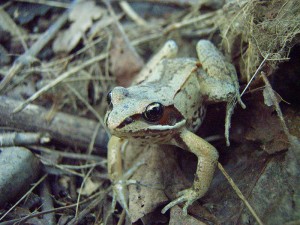Have you ever wondered how some animals in the northern climates survive the harsh cold winters? Well, the Arctic Frog or Wood Frog (known in the science community as Rana sylvatica) survives like no other. This special amphibian has adapted to the cold winters in a very special way.
The Wood frog has a special ability that no other frog has. This little guy can survive many weeks with 2/3 or actually about 65% of its body water completely frozen. It will live like this until it thaws out in warmer weather and then resume life as normal. This special frog lives anywhere from Georgia all the way up to parts of Canada. Jon Costanzo of Miami University in Ohio has led an experiment over 25 years to try and understand just how this crazy adaptation works. During this period of freeze this Wood Frogs heart stops beating and it stops breathing for maybe up to weeks at a time. Days when the temperature reaches above freezing the frog will unfreeze and resume life as normal and when the temp drops back down it will freeze again. Depending on where the specific frog lives will depend on its freeze tolerance. The frogs which were tested were from Ohio there freeze tolerance was 24.8 degrees before they started freezing but the ones found in Canada didn’t freeze until 3.2 degrees fahrenheit meaning they had a higher freezing tolerance.
Now you may be wondering how does this frog survive these harsh winters? The answer is cryoprotectants. This basically means once the temperature of the frog reaches a certain level, the blood sugar and urea and body tissues freeze. The higher the level of cryoprotectants the increased chance of survival for the frog. In most animals if there body is exposed to cold temperatures for to long there body freezes and cells shrink to an unhealthy size usually causing death. Costanzo believes the Wood Frogs in the North have a special solute that keeps them alive easier compared to the one in Ohio. Basically without sugar the frogs would not survive the coldness.
So how can we use this information to help our lives? Imagine being able to freeze someone to near the point of death and being able to thaw them out and have them come back to life and live a normal life afterwards. If someone has a cancer and as of now there is no cure for this cancer what if we could freeze them and maybe 30 years when we find a cure thaw them out, cure them, and then live a happy life. Or it could also help find a more efficient method of freezing and using someone’s organs. If someone was an organ donor and died in an accident there organs could be frozen and sent much further places because of the research information that has been discovered from these frogs. Imagine if someone had died in somewhere like California but someone was dieing in Germany. If we could periodically freeze this person’s organ’s we could easily get the organs to the dieing patient in Germany in time and the organs would be fine.
So even though not many people know about this amazing adaptation it could be affecting you way more then you think. It’s amazing to think that anything can survive with its entire exterior of its body frozen and 65% of its interior bodily fluids completely frozen. If it didn’t eat so much sugar and those things it wouldn’t be able to survive. And what if one day we use information developed by frogs to save someone. Who would’ve thought that we could potentially be revolutionized by something so simple but yet something so complex.
1. Are these frogs being affected by climate change?
2. Are any other animals able to freeze and survive?
3. How can this discovery influence the medical field?

Matthew,
you did such a great job on this blog post. Your first sentence got me very interested in the topic. I really enjoyed reading your blog post about frogs and their climate. Some of your interesting and descriptive words really got me interested in the topic. This is by far the best post I have read on this blog site.
http://www.google.com/url?sa=t&rct=j&q=&esrc=s&frm=1&source=web&cd=2&ved=0CDUQFjAB&url=http%3A%2F%2Fwww.sciencekids.co.nz%2Fsciencefacts%2Fanimals%2Ffrog.html&ei=stpnU-XkK6OMygGE74FQ&usg=AFQjCNG623r9ZdUb6pl_qzerUdOPW5ASHg&sig2=WNZdkwiTTFLfhn8pQ-n5Cw&bvm=bv.65788261,d.aWc
Matt,
I extremely enjoyed reading about the amazing creature that is the wood frog. I find it spectacular that such an adaptation can exist. In my glee I decided to do a little bit more research. I found that the wood frog has its own antifreeze that prevents ice from freezing within their cells. Otherwise such freezing temperatures would be deadly. What is interesting is that ice does form between the cells, and when it gets warmer it thaws out. Wood frogs are one of the first to start the mating season when it gets warm, and they are one of the best able to recognize their family. When they are just mere tadpoles, the siblings group up and stay together. The lifespan of these creatures is about 3 years in the wild, and the maturity age is at about 1-2 years.
I found my information at:
http://www.nwf.org/Wildlife/Wildlife-Library/Amphibians-Reptiles-and-Fish/Wood-Frog.aspx
Matthew,
You did a nice job researching freeze tolerance in the wood frog. Your readers might like to know that there are four other species of freeze-tolerant frogs native to North America. Can you find out which species they are?
I was interested to read your comments about possibly using information about natural freeze tolerance to solve medical problems. That’s a good example of “applied science” or “translational research.” But we need to remember that “basic research” is always the starting point. I research wood frogs simply because I find them fascinating!
Great piece!